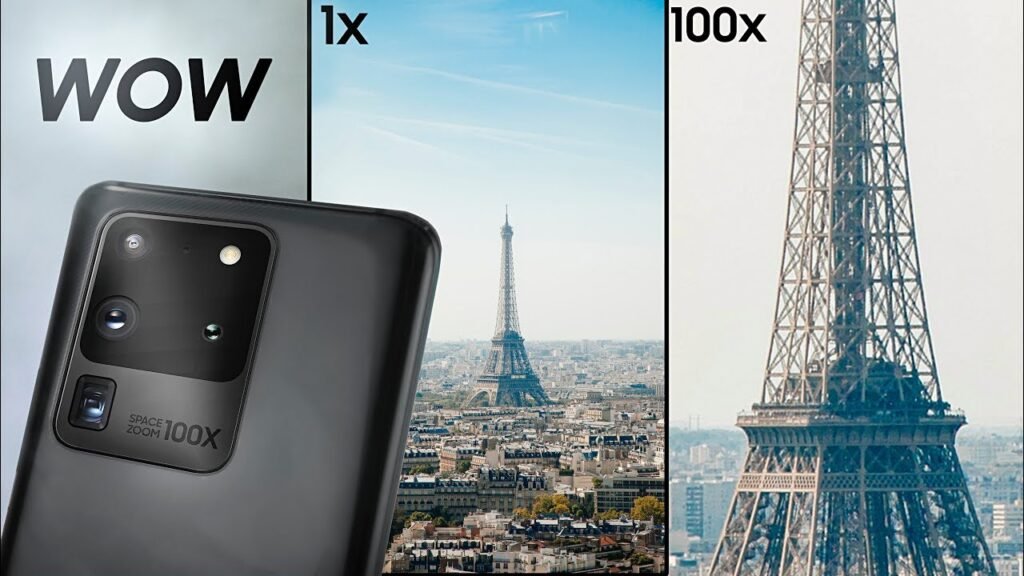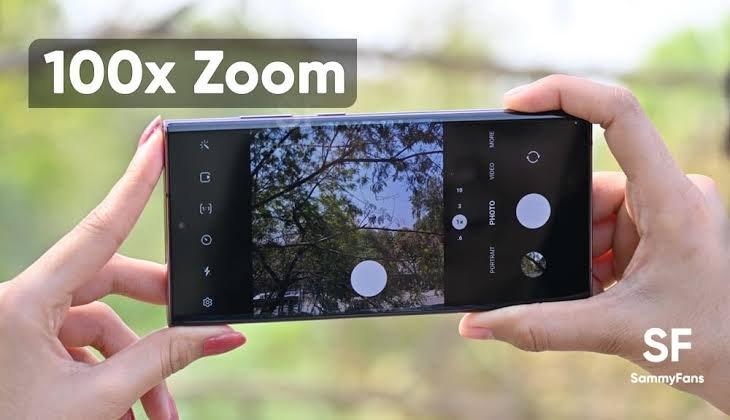Smartphone photography has evolved dramatically over the past decade, with manufacturers constantly pushing the boundaries of what’s possible in a mobile device. One of the most impressive advancements in recent years is the introduction of powerful zoom capabilities in Android smartphones, particularly the 100x zoom feature. This capability, which was once reserved for professional cameras, is now available in the palm of your hand, allowing users to capture incredibly detailed images from great distances. This article explores the 100x zoom feature in Android smartphones, detailing its workings, features, pros, cons, alternatives, and more.
What is 100x Zoom In Android?
The 100x zoom in Android refers to a feature found in some high-end smartphones that allows users to zoom in up to 100 times on a subject while taking photos or recording videos. This level of zoom is achieved through a combination of optical zoom, which physically moves the lens to get closer to the subject, and digital zoom, which enlarges the image using software algorithms. The result is an incredibly powerful zoom capability that can capture details that would be impossible to see with the naked eye.

This feature is particularly useful for capturing distant objects, such as wildlife, architectural details, or even the moon. While the 100x zoom is a significant technical achievement, it also raises questions about image quality, usability, and whether this level of zoom is necessary for everyday photography.
How 100x Zoom In Android Works
The 100x zoom in Android smartphones works through a combination of hardware and software technologies. Here’s a breakdown of how it operates:
Optical Zoom
Optical zoom involves the physical movement of the camera lens to magnify the subject. This type of zoom maintains image quality because it doesn’t rely on software to enlarge the image. High-end Android smartphones with 100x zoom typically use a periscope-style telephoto lens that bends light at a 90-degree angle to achieve greater zoom without requiring a bulky lens system.
Digital Zoom
Digital zoom enlarges the image through software, cropping the photo and then digitally enlarging the cropped section. While this allows for greater zoom levels, it often results in a loss of image quality, particularly at the higher end of the zoom range. The challenge with digital zoom is maintaining clarity and reducing noise, which manufacturers address through advanced image processing algorithms.
Hybrid Zoom
The 100x zoom feature combines optical and digital zoom to provide a seamless zoom experience. The optical zoom handles the initial magnification, while the digital zoom takes over for further enlargement. Manufacturers use software to enhance the digitally zoomed image, applying noise reduction, sharpening, and other enhancements to improve quality.
Image Stabilization
One of the challenges with extreme zoom levels is maintaining a steady image. Even slight hand movements can result in a blurry photo. To counteract this, smartphones with 100x zoom often include optical image stabilization (OIS) and electronic image stabilization (EIS). OIS physically adjusts the lens to counteract movements, while EIS uses software to stabilize the image.
AI and Image Processing
Artificial intelligence (AI) plays a significant role in enhancing zoomed images. AI algorithms can recognize the subject, optimize exposure, reduce noise, and sharpen details, all of which are crucial when dealing with the limitations of digital zoom. This processing happens in real-time, allowing users to see a preview of the enhanced image before capturing it.
Features of 100x Zoom In Android
The 100x zoom feature in Android smartphones comes with several advanced features that make it a standout in mobile photography. Here are the key features in detail:
Periscope Lens
The periscope lens design is a significant innovation that allows for high levels of optical zoom without adding bulk to the smartphone. By bending light through a prism, this lens system achieves greater magnification while keeping the phone’s profile slim.
Super Resolution
To maintain image quality at high zoom levels, Android smartphones with 100x zoom often use super resolution technology. This feature combines multiple frames of the same image to produce a single high-resolution photo. The result is a clearer, more detailed image, even when zoomed in.
AI-Powered Enhancements
AI plays a critical role in the 100x zoom feature, enhancing image quality through various algorithms. These include scene recognition, which adjusts settings based on what the camera is capturing, and detail enhancement, which sharpens the image and reduces noise.
Space Zoom
Space Zoom is a branding term used by some manufacturers to describe their 100x zoom feature, particularly when capturing distant objects like the moon. This feature is designed to optimize settings for astronomical photography, ensuring that even distant celestial bodies are captured clearly.
Dual Optical Image Stabilization
To ensure that zoomed images remain sharp, especially at 100x, dual optical image stabilization is often employed. This system stabilizes both the primary and telephoto lenses, reducing the impact of hand movements and allowing for clearer photos.
Zoom Lock
At extreme zoom levels, even minor hand movements can make it difficult to keep the subject in frame. Zoom Lock is a feature that uses AI to detect and lock onto the subject, minimizing the effects of movement and ensuring that the subject remains centered in the frame.
Enhanced Night Mode
Zooming in low light conditions can be particularly challenging, but enhanced night mode features on these smartphones help capture detailed images even in dim lighting. This feature combines multiple exposures, reduces noise, and enhances details to produce a bright, clear image.
8K Video Recording
Some Android smartphones with 100x zoom also offer 8K video recording capabilities. This allows users to capture incredibly detailed video footage, with the added benefit of being able to extract high-resolution still images from the video.
Real-Time Preview
When using the 100x zoom, real-time preview features allow users to see how the final image will look with AI enhancements applied. This helps in framing the shot and making adjustments before capturing the photo.
High Dynamic Range (HDR)
HDR technology is often integrated with the 100x zoom feature, balancing exposure across the image to ensure that both bright and dark areas are well-lit and detailed. This is especially useful when zooming in on subjects with varied lighting conditions.
Pros of 100x Zoom In Android
| Pros | Description |
|---|---|
| Incredible Reach | Allows users to capture distant objects with unprecedented clarity. |
| Advanced Image Processing | AI and software enhancements improve image quality even at extreme zoom levels. |
| Compact Design | Periscope lens design offers high zoom without increasing the phone’s bulk. |
| Versatility in Photography | Suitable for a wide range of photography, from wildlife to astrophotography. |
| Innovative Features | Features like Zoom Lock and dual OIS enhance usability and image stability. |
Cons of 100x Zoom In Android
| Cons | Description |
|---|---|
| Image Quality Degradation | At the maximum zoom, image quality may degrade, especially in low light. |
| Steep Learning Curve | Utilizing the full potential of 100x zoom requires understanding advanced features. |
| Battery Consumption | High zoom levels and image processing can drain the battery quickly. |
| Limited Practical Use | 100x zoom may be overkill for everyday photography needs. |
| High Cost | Smartphones with this feature are typically high-end and expensive. |
100x Zoom In Android Alternatives
| Alternative | Description | Key Features |
|---|---|---|
| Samsung Galaxy S21 Ultra | A leading Android phone with 100x zoom and advanced camera features. | Periscope lens, 108MP sensor, dual OIS, Space Zoom. |
| Huawei P40 Pro+ | Offers a 100x zoom feature with AI-powered image enhancements. | Periscope telephoto lens, 50MP main camera, advanced AI capabilities. |
| Google Pixel 7 Pro | Focuses on AI-driven photography with up to 50x zoom. | Super Res Zoom, excellent low-light performance, AI scene recognition. |
| Xiaomi Mi 11 Ultra | Features 120x digital zoom, surpassing the 100x mark for extreme close-ups. | Periscope lens, dual image stabilization, 8K video recording. |
| Oppo Find X3 Pro | Known for its high-quality camera system with up to 60x zoom. | Microlens camera, 10-bit color capture, advanced image processing. |
Conclusion and Verdict 100x Zoom In Android
The introduction of 100x zoom in Android smartphones is a remarkable achievement in mobile photography, bringing professional-level zoom capabilities to everyday users. While the feature offers incredible opportunities for capturing distant subjects, it also comes with challenges, such as maintaining image quality at high zoom levels and the practicality of such a feature for average users. However, for photography enthusiasts and those who frequently capture distant subjects, the 100x zoom is a game-changer, offering versatility and innovation in a compact form. Despite its drawbacks, the 100x zoom in Android smartphones represents a significant leap forward in mobile technology, pushing the boundaries of what is possible with a smartphone camera.
FAQs 100x Zoom In Android
What smartphones have 100x zoom capability?
Smartphones like the Samsung Galaxy S21 Ultra, Huawei P40 Pro+, and Xiaomi Mi 11 Ultra feature 100x zoom capabilities.
How does 100x zoom impact image quality?
While 100x zoom allows for extreme close-ups, it can lead to a loss of image quality, especially at the maximum zoom level where digital zoom is heavily relied upon.
Is 100x zoom practical for everyday use?
For most users, 100x zoom is not necessary for everyday photography. It is more suited for specific scenarios, such as wildlife photography or capturing distant objects.
What are the best alternatives to 100x zoom smartphones?
Alternatives include the Google Pixel 7 Pro, Oppo Find X3 Pro, and other smartphones that offer high zoom levels with excellent image quality and advanced features.
How does image stabilization work with 100x zoom?
Image stabilization, including optical and electronic stabilization, helps reduce the effects of hand movements, ensuring clearer images even at high zoom levels.
